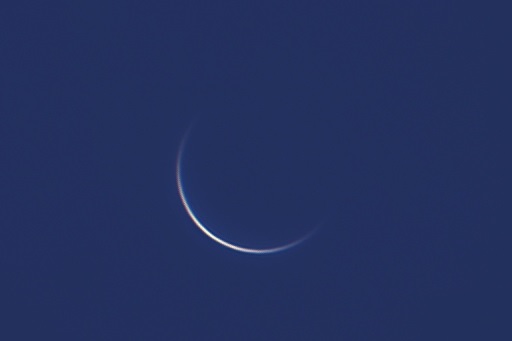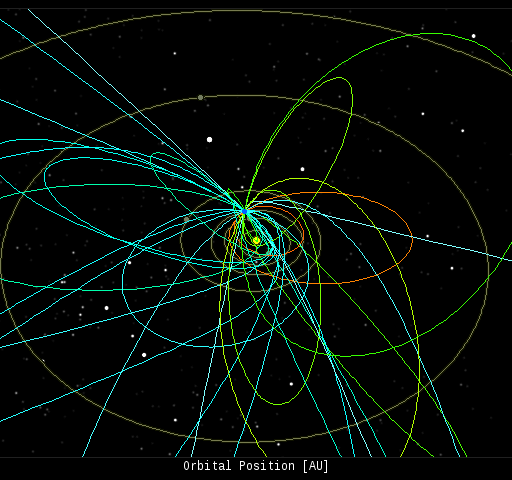When is the best time to see auroras? Where is the best place to go? And how do you photograph them? These questions and more are answered in a new book, Northern Lights - a Guide, by Pal Brekke & Fredrik Broms. | | | X-FLARE: Giant sunspot AR1944 erupted on Jan 7th at approximately 1832 UT, producing a powerful X1-class solar flare. First-look coronagraph images from the STEREO-Ahead spacecraft appear to show a coronal mass ejection (CME) emerging from the blast site. If so, the CME is almost certainly heading for Earth. Stay tuned for updates as more data arrive from the NASA-ESA Heliophysics Fleet. Solar flare alerts: text, voice. HUGE SUNSPOT TARGETS EARTH: One of the biggest sunspots in years is crossing the center of the solar disk, putting Earth in the way of potential eruptions. Rocky Raybell photographed the active region named "AR1944" yesterday from his backyard in Keller, Washington: 
The sprawling sunspot contains dozens of dark cores, the largest big enough to swallow Earth three times over. This makes it an easy target for amateur solar telescopes -- or even regular cameras. Raybell used an SX40 digital camera on a tripod whole holding a Baader solar filer over the lens to capture his image. Photo details may be found here. Although AR1944 has been mostly quiet for days, flares are in the offing. The sunspot has an unstable 'beta-gamma-delta' magnetic field that could erupt at any time. NOAA forecasters estimate a 75% chance of M-class flares and a 30% chance of X-flares on Jan. 7th. 
Above: A 4-day movie of AR1944 from the Solar Dynamics Observtory
Realtime Space Weather Photo Gallery CME IMPACT: A coronal mass ejection (CME) hit Earth's magnetic field on Jan. 7th at approximately 1500 UT. The glancing impact did not immediately spark a geomagnetic storm. However, storm conditions could develop as Earth travels through the CME's wake. High latitude sky watchers should remain alert for auroras. Aurora alerts: text, voice. VENUS, THE CRESCENT PLANET: Venus is turning its night side toward Earth as it approaches inferior solar conjunction on Jan. 11th. Barely 1% of Venus's sunlit hemisphere is now facing us, which means the planet looks like a razor-thin crescent. If you have a GOTO telescope, command it to slew to Venus. It's visible even in broad daylight: 
Shahrin Ahmad of Sri Damansara, Malaysia, took the picture on Jan. 6th using a 4.5 inch telescope. "As Venus gets closer to the sun, it gets thinner everyday!" says Ahmad. "So far, this is the thinnest Venus I've managed to photograph--a mere 9.5o from the sun and just 1.3% illuminated!" Realtime Venus Photo Gallery
Realtime Aurora Photo Gallery
Realtime Comet Photo Gallery
Every night, a network of NASA all-sky cameras scans the skies above the United States for meteoritic fireballs. Automated software maintained by NASA's Meteoroid Environment Office calculates their orbits, velocity, penetration depth in Earth's atmosphere and many other characteristics. Daily results are presented here on Spaceweather.com. On Jan. 7, 2014, the network reported 30 fireballs.
(29 sporadics, 1 Quadrantid) 
In this diagram of the inner solar system, all of the fireball orbits intersect at a single point--Earth. The orbits are color-coded by velocity, from slow (red) to fast (blue). [Larger image] [movies] On Jan. 6, 2014, the network reported 7 fireballs.
(6 sporadics, 1 alpha Hydrid) 
In this diagram of the inner solar system, all of the fireball orbits intersect at a single point--Earth. The orbits are color-coded by velocity, from slow (red) to fast (blue). [Larger image] [movies] Potentially Hazardous Asteroids ( PHAs) are space rocks larger than approximately 100m that can come closer to Earth than 0.05 AU. None of the known PHAs is on a collision course with our planet, although astronomers are finding new ones all the time. On January 7, 2014 there were 1449 potentially hazardous asteroids. Notes: LD means "Lunar Distance." 1 LD = 384,401 km, the distance between Earth and the Moon. 1 LD also equals 0.00256 AU. MAG is the visual magnitude of the asteroid on the date of closest approach. | | The official U.S. government space weather bureau | | | The first place to look for information about sundogs, pillars, rainbows and related phenomena. | | | Researchers call it a "Hubble for the sun." SDO is the most advanced solar observatory ever. | | | 3D views of the sun from NASA's Solar and Terrestrial Relations Observatory | | | Realtime and archival images of the Sun from SOHO. | | | from the NOAA Space Environment Center | | | the underlying science of space weather | | 
